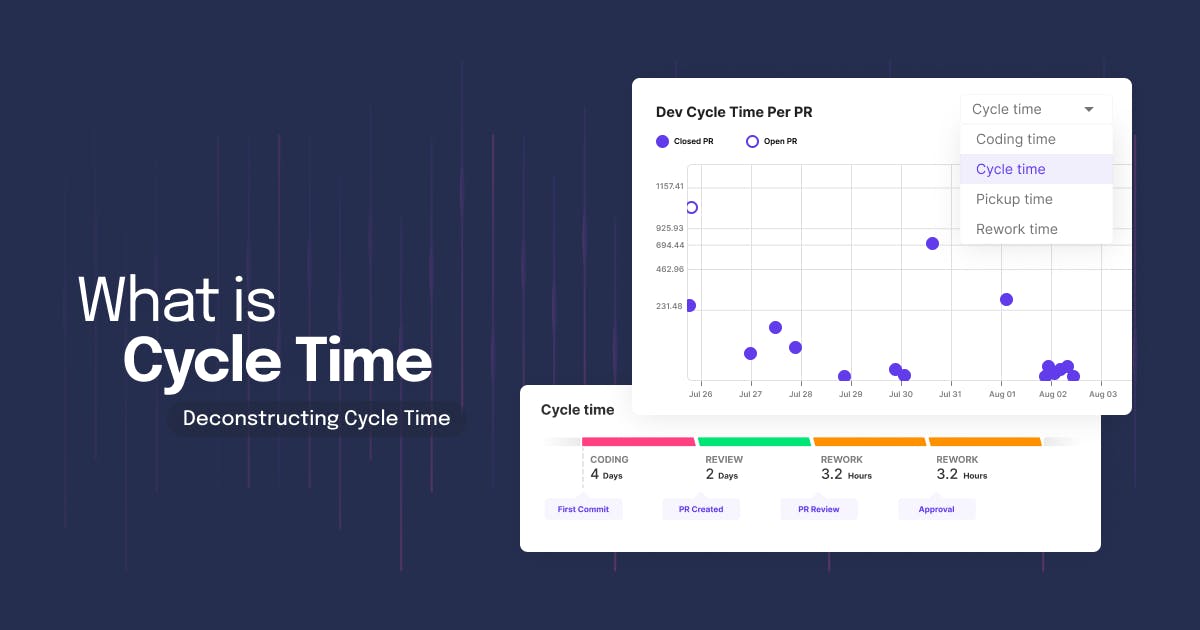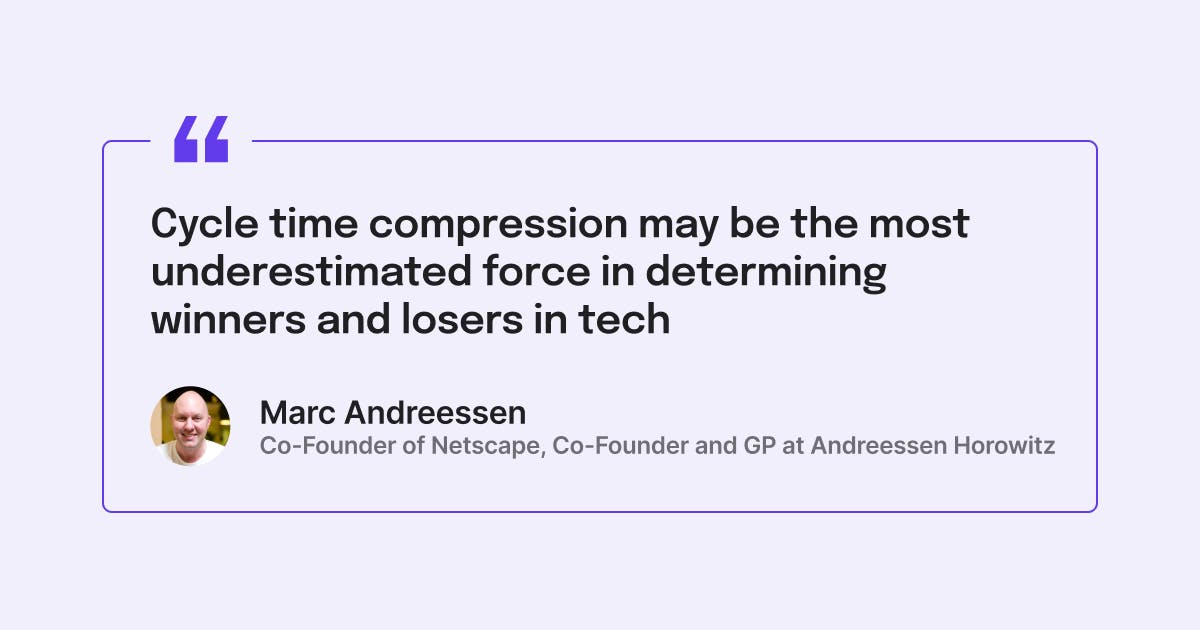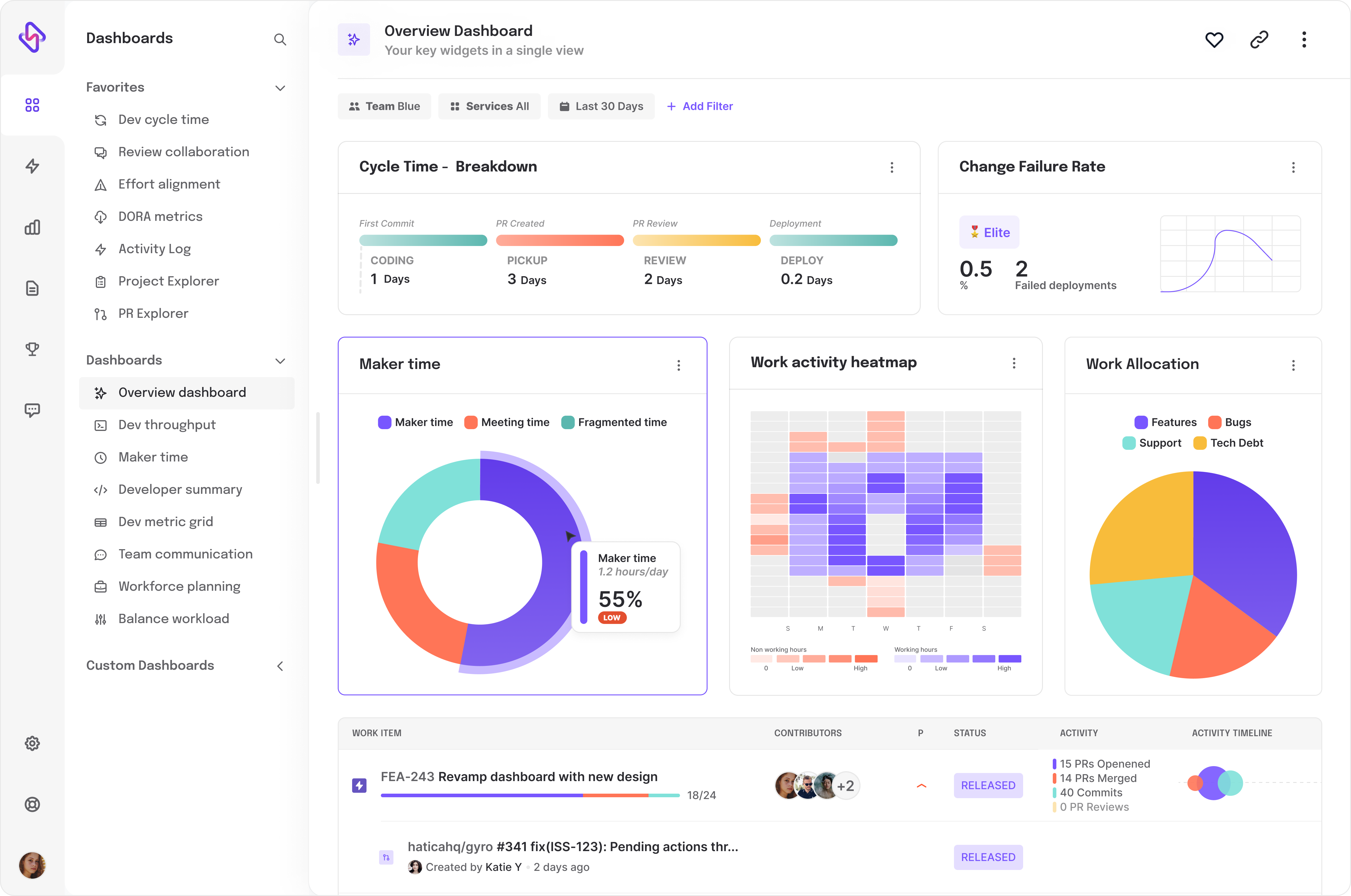- Coding Time: The time spent writing the code.
- Pickup Time: How long it takes for someone to start reviewing the code.
- Review Time: The time spent reviewing and providing feedback.
- Deploy Time: The time it takes to get the code into production.
In essence, cycle time is a metric that reflects how fast and efficiently a team can deliver a task. By measuring the time it takes to complete a piece of software, from start to finish, teams can identify areas for improvement and boost their overall productivity.
How to Calculate Cycle Time?
The formula to calculate cycle time is pretty simple:
Here’s the math
Cycle Time = Total Work Time / Number of Things Built
Let’s walk through this step by step:
- Determine Actual Work Time
Start by figuring out how much time your team actually spent working. This means subtracting non-productive time—like breaks, meetings, or any other interruptions—from your total work hours. The remaining time is your net production time. - Count the Completed Work
Next, tally up the number of items your team finished. This could be anything from new features, bug fixes, or any other tasks you consider done. - Calculate Cycle Time
Finally, divide the total work time by the number of completed items. This gives you the average time it took to complete each task or feature.
Imagine your team worked a total of 40 hours this week. After accounting for 8 hours spent in meetings and breaks, you have 32 hours of actual work time. During this period, your team successfully completed 8 features.
Here’s the calculation: Cycle Time = 32 hours / 8 features = 4 hours per feature
So, on average, it took your team 4 hours to build each feature.
Comparison of Cycle Time vs. Lead Time vs. Takt Time
If you've already got a grasp on what cycle time is, let's shift gears and look at how it stacks up against two other crucial metrics: lead time and takt time. While these terms might seem interchangeable at first glance, each one offers a unique perspective on your team’s workflow.
1. Cycle Time
You've already read about how cycle time tracks the duration it takes to finish a single task, like developing a feature. It's your go-to metric for understanding the efficiency of individual processes. But what happens when we zoom out?
2. Lead Time
Think of lead time as the bird’s-eye view of your project. While cycle time hones in on the task itself, lead time covers the entire journey from the moment a request lands on your desk to the moment the final product is delivered. It’s not just about coding—lead time includes planning, design, testing, and everything in between. It's the big picture that helps you understand how long your customers or stakeholders have to wait.
You can check out Cycle Time Vs Lead Time for more details.
3. Takt Time
Now, let’s talk takt time. If cycle time is about the efficiency of tasks and lead time is about the overall process, takt time is the rhythm that keeps everything in sync with demand. Takt time answers the question: How fast do we need to complete each task to keep up with customer needs? It’s not just about working faster—it’s about working at the right pace to meet expectations without overwhelming your team.
Why All Three Matter?
While cycle time is crucial for spotting inefficiencies in specific tasks, lead time helps you see where the whole process can be streamlined. And takt time ensures that your work rhythm aligns with customer expectations. Together, these metrics give you a comprehensive toolkit for managing both the speed and quality of your development process.
By understanding the differences and the roles each metric plays, you can better fine-tune your workflow, ensuring that every part of your development process runs smoothly and efficiently.
Now let’s get into why focusing on cycle time is important!
Why is Cycle Time Important?
Cycle time isn’t just another metric—it’s a window into the health and efficiency of your development process. Understanding and optimizing cycle time offers several critical benefits that can make or break your success in the fast-paced world of software development.
1. Slower Time to Market and the Risk of Falling Behind Competitors
Every day a feature sits locked in development is a day your competitors are leaving you behind. Amazon was losing out on 1% of their sales before they amped up their cycle time to reduce deliveries from 6 hours to 10 minutes. Imagine the lost opportunities and stagnant growth associated with a sluggish cycle time.
The market moves fast, and slow teams miss out on capturing emerging opportunities. Moreover, your rivals get to users first, potentially shaping market preferences, and you stand with a potential threat of being locked out. On top of it, missed deadlines and delayed features damage customer trust and brand reputation, there you lose your CX advantage to your competitors.
2. Poor Developer Experience (DevEx)
We all know how frustrating it can be to work on a project that seems to drag on endlessly. Long cycle times can lead to exactly that—frustrated developers who feel like they’re spinning their wheels. When cycle time is high, it’s often a sign that something’s off, whether it’s unclear requirements, cumbersome processes, or constant rework. This not only drags down productivity but can also hurt morale. On the other hand, when cycle time is optimized, developers experience a smoother workflow, clearer goals, and quicker wins, leading to a more positive and motivating work environment.
3. High Rework and Code Churn
The pressure to "hurry up and get it done" breeds hasty, poorly-written code. This becomes a vicious cycle: rush to deploy, encounter bugs, rewrite code, repeat. All in the bid to control an inflated cycle time.
This technical debt translates to future bugs, constant firefighting, and delayed releases. It also means your features stand at the risk of becoming obsolete or irrelevant, improving the instances of wasted effort and resources.
Cycle time is not just about speed. It's about balancing speed with quality and ensuring you're delivering critical features to end customers.
What Are the Challenges of Calculating Cycle Time?
On the surface, calculating cycle time might seem like a straightforward task—just measure how long it takes to complete a piece of work, right? But when you dig a little deeper, you’ll find that several challenges can make this process more complex than it initially appears.
One of the biggest hurdles is task variability. In software development, no two tasks are exactly the same. Some features might be simple and quick to develop, while others are more complex and require more time and effort. This variability can lead to fluctuating cycle times, making it harder to get a consistent measurement.
Another challenge is the integration of different tools and systems. Modern development workflows often involve a variety of tools—version control systems, project management software, continuous integration pipelines, and more. Ensuring that all these tools are in sync and that they’re accurately tracking time can be tricky. Even a small discrepancy can throw off your calculations, leading to inaccurate cycle time measurements.
There’s also the issue of consistency in tracking. To get an accurate picture of cycle time, you need to track it consistently across all tasks and projects. But in the hustle and bustle of development, it’s easy for things to fall through the cracks. Maybe a task gets logged late, or perhaps the time spent on a specific phase isn’t recorded accurately. These inconsistencies can skew your data, making it difficult to rely on the results.
Despite these challenges, overcoming them is crucial if you want to use cycle time as a reliable metric for improvement. It’s not just about having the data—it’s about having accurate data that truly reflects how your team is performing.
Who Calculates Cycle Time?
So, who’s in charge of keeping tabs on cycle time? Typically, this responsibility falls to the engineering managers and team leads—the ones who are always on the lookout to make sure everything’s running smoothly and the team is performing at its best.
These managers and leads rely on cycle time to get a clear picture of the team's efficiency. By keeping an eye on this metric, they can spot where things are going well and where there might be room for improvement. For instance, if they see that cycle time is consistently longer for certain tasks, they’ll dig a bit deeper to figure out what’s slowing things down and how to fix it.
But here’s the thing: they’re not doing this alone. They’ve got some pretty handy tools and dashboards that do a lot of the heavy lifting.
Engineering management platforms are helping them crunch these numbers. Learn more about them here.
Such a platform automatically tracks how long different tasks take, crunches the numbers, and presents the data in a way that makes sense. With all this information at their fingertips, managers can make smart, data-driven decisions that boost the engineering team’s productivity.
In the end, calculating cycle time is a team effort, backed by technology, that helps leaders guide their teams toward better efficiency and success.
It’s all about understanding the data, making sense of it, and using it to steer an engineering team in the right direction.
Let's break down cycle time with a real-world example.
Example of Calculating Cycle Time





